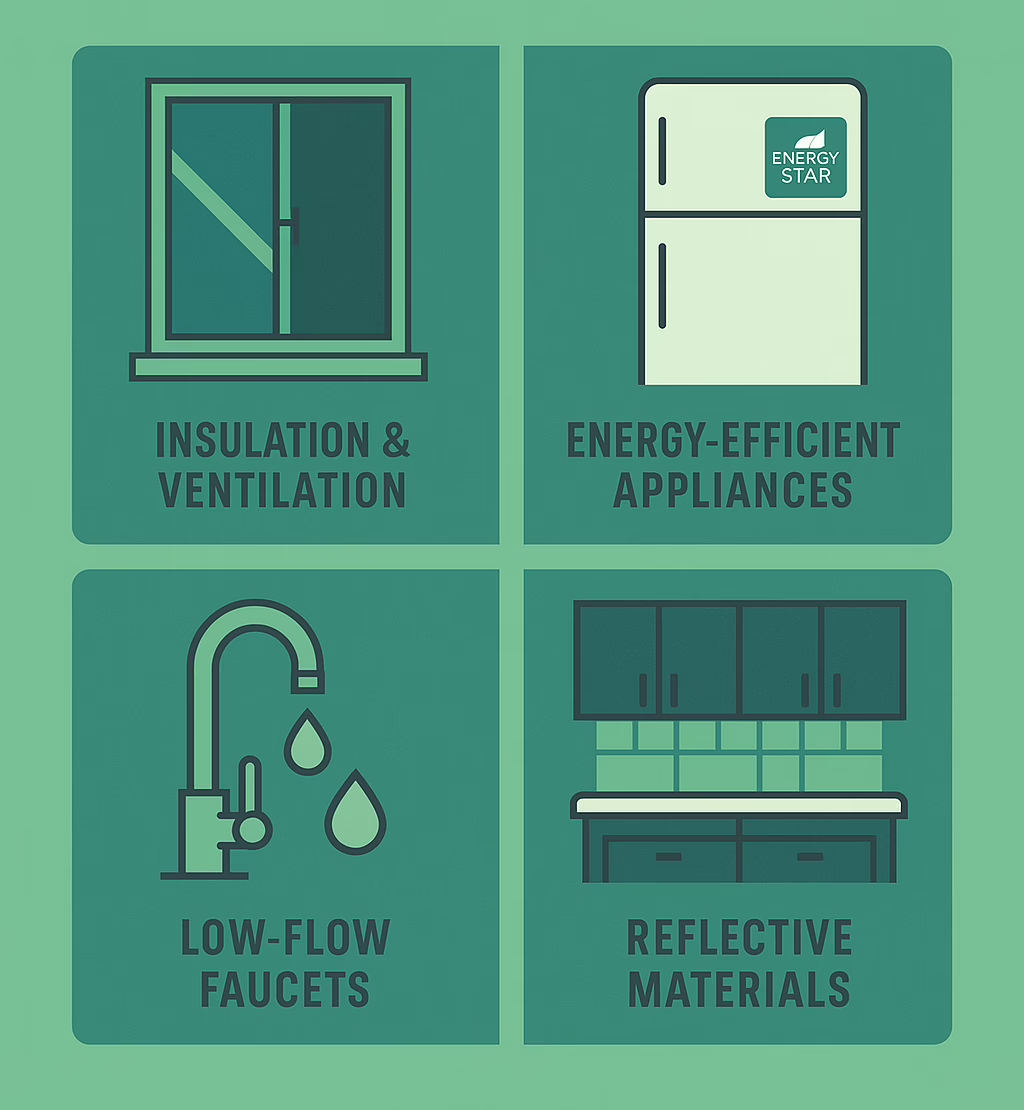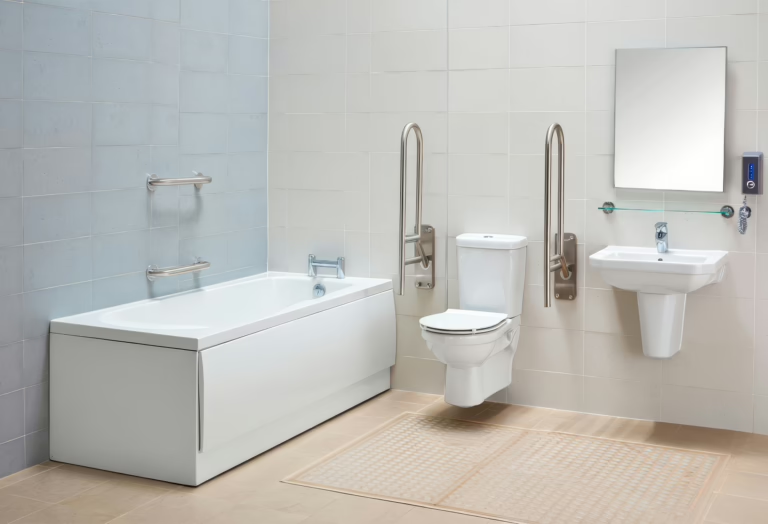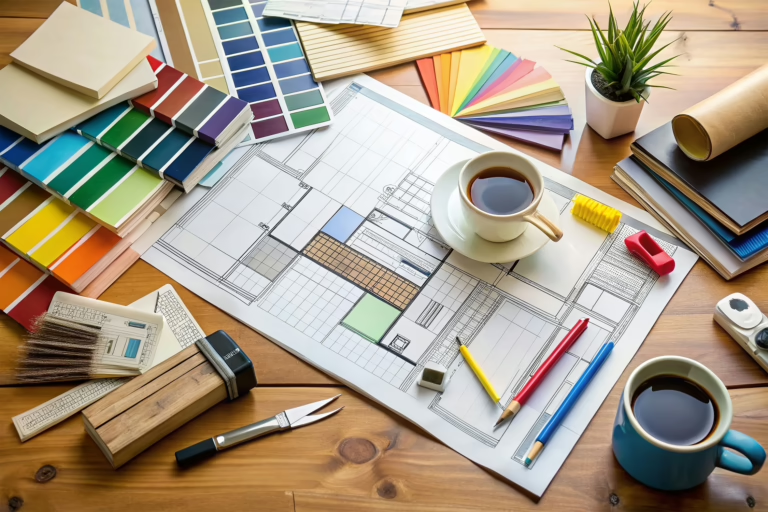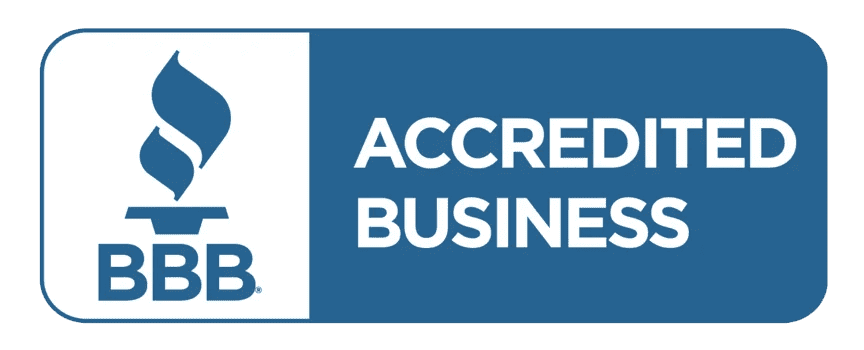In the Southwest—especially in areas like Albuquerque, NM—the combination of scorching summer heat, dry desert air, and intense sunshine makes energy-efficient kitchen renovations a high priority for homeowners. Whether you’re concerned about lowering your utility bills, reducing your environmental footprint, or simply maintaining a more comfortable indoor environment, the design choices you make during a kitchen remodel can have a huge impact on both your finances and day-to-day comfort. At Hunter Builders in Albuquerque, we specialize in energy-efficient kitchen renovations in the Southwest, helping you make informed decisions that marry style with sustainability.
In this comprehensive guide, we’ll explore how to make your Southwest kitchen renovation more efficient, from selecting the right materials to installing advanced appliances. Along the way, we’ll highlight the best appliances for reducing energy costs, discuss how to make a kitchen more efficient in a hot, dry climate, and dig into the cost of kitchen remodel projects in New Mexico—particularly when you’re focusing on energy savings. Let’s dive into the details of crafting an efficient, modern kitchen that can stand up to the Southwest heat while remaining beautiful and functional for years to come.
Understanding Energy Efficiency in a Southwest Climate
The Southwest region—which includes parts of New Mexico, Arizona, Texas, Nevada, and Southern California—features a climate characterized by hot summers, low humidity, and substantial temperature swings between day and night. In locations like Albuquerque, NM, homeowners face unique challenges in keeping interiors cool without driving up energy bills. Kitchens, in particular, generate heat from cooking appliances, lighting, and electronics. Therefore, approaching a kitchen remodel with energy efficiency at the forefront can lead to substantial savings and a more comfortable home environment.
Key Climate Factors Affecting Kitchen Energy Use
- High daytime temperatures: Air conditioning systems work harder to offset the ambient heat.
- Low humidity: Dry air can exacerbate heat in the home if not balanced properly.
- Intense sunshine: Solar heat gain through windows can raise indoor temperatures.
- Rapid temperature drops at night: Designing for ventilation can use cooler nights to reduce indoor heat without excessive AC use.
Pro Tip: Understanding these climate-specific factors lets you tailor your kitchen renovation approach for maximum efficiency gains. This includes strategic window placement, insulation, and using materials that naturally stay cooler in high temperatures.
Planning Your Energy-Efficient Kitchen Layout
A well-thought-out kitchen layout not only enhances workflow but also significantly affects energy efficiency. For example, placing the refrigerator next to a range or oven can make the fridge work harder, due to the heat produced by cooking appliances.
Layout Considerations
- Separate Heat-Generating Appliances
- Keep your oven and cooktop away from the refrigerator or freezer. This reduces unnecessary warming of cold appliances.
- Maximize Natural Light
- Large, well-placed windows or a skylight can reduce your reliance on artificial lighting during the day, cutting energy costs.
- Create Proper Ventilation Paths
- An open-concept kitchen can circulate air more efficiently, and strategic use of ceiling fans can further improve airflow.
- Add a Kitchen Island
- Islands can serve as both a functional workspace and a barrier that shields the rest of the home from cooking heat.
Pro Tip: When possible, orient your kitchen so that it receives morning light rather than the intense afternoon sun. This can keep your space cooler during peak heat hours.
Selecting Energy-Saving Materials and Finishes
The materials you choose for cabinetry, flooring, countertops, and backsplashes can influence how much heat your kitchen retains or reflects. Similarly, certain finishes might contribute to insulation, while others can help keep surfaces cool to the touch.
Best Materials for a Southwest-Inspired, Energy-Efficient Kitchen
- Light-Colored Countertops
- Surfaces such as light-toned quartz or granite reflect more light and absorb less heat. This keeps your kitchen feeling cooler and reduces the demand on air conditioning.
- Ceramic or Porcelain Tile Flooring
- Tiles with higher thermal mass can stay cooler underfoot in hot, dry climates. Tile also releases absorbed heat more slowly, regulating indoor temperature.
- Sustainably Sourced Woods
- If you prefer hardwood floors or wooden cabinets, opt for materials certified by the Forest Stewardship Council (FSC). Lighter finishes reflect heat rather than absorbing it.
- Reflective Backsplashes
- A backsplash made of reflective or lighter-hued materials can bounce natural light around the room. This reduces your need for artificial lighting during the day.
- Composite or Recycled Materials
- Materials like recycled glass countertops or composite floors can be both eco-friendly and good at managing thermal transfer.
Pro Tip: Consider installing window treatments—such as thermal drapes or shades—to block out the most intense rays of the sun, particularly in the afternoons. This can drastically reduce indoor heat gain.
Choosing High-Efficiency Appliances
One of the most influential factors in energy-efficient kitchen renovations is your choice of appliances. From your refrigerator and dishwasher to your oven and stove, modern appliances are designed to operate with far less electricity or gas than older models.
Best Appliances for Reducing Energy Costs
- ENERGY STAR® Certified Refrigerators
- Refrigerators labeled with ENERGY STAR® use significantly less power than standard models. They also come in various sizes and styles, including French door and top freezer options.
- Induction Cooktops
- Induction technology generates heat directly in the cookware, rather than transferring it from a burner. This leads to faster cooking times and less waste heat, which can keep your kitchen cooler.
- High-Efficiency Dishwashers
- Newer dishwashers often include features like soil sensors and short-cycle options, minimizing water and energy usage.
- Convection Ovens
- Convection ovens circulate hot air, reducing cooking times and energy consumption compared to conventional ovens.
- Microwave or Speed Oven
- For smaller meals, using a microwave or specialized speed oven consumes far less energy than a full-size oven or range.
Pro Tip: While energy-efficient appliances might come with a higher upfront cost, they typically pay for themselves over time through lower utility bills—especially in regions with high electricity rates.

Optimizing Lighting for Lower Energy Bills
Lighting can account for a surprisingly large chunk of your kitchen’s energy consumption if you rely on outdated fixtures or bulbs. In the Southwest, where days are often sunny, you have an opportunity to maximize natural light while strategically supplementing it with energy-efficient solutions.
Efficient Lighting Strategies
- LED Bulbs
- LED bulbs use up to 80% less energy than incandescent bulbs and last significantly longer. They also emit less heat, easing the burden on your cooling system.
- Smart Lighting Controls
- Motion sensors, dimmers, or smart home systems allow you to adjust brightness or automatically switch off lights when not in use.
- Under-Cabinet Lighting
- Placing LED strip lights under cabinets can illuminate countertops while consuming minimal energy. This also reduces the need for brighter overhead fixtures.
- Task Lighting vs. Ambient Lighting
- Focus on targeted task lighting around the sink, stove, and countertops to reduce the need for strong overhead lighting throughout the entire space.
Pro Tip: Consider installing a solar tube (also known as a sun tunnel) if you have a roof that can accommodate it. These tubes channel sunlight directly into your kitchen, cutting daytime electricity usage.
Insulation and Ventilation: Beating the Heat
In the Southwest, controlling your home’s internal temperature is paramount. Proper insulation helps keep your kitchen cool by preventing the intrusion of hot outside air, while ventilation strategies (like a powerful range hood and well-placed vents) ensure hot air and cooking fumes are efficiently expelled.
Important Insulation and Ventilation Tips
- Sealed Windows and Doors
- Check for drafts around window frames and door thresholds. Use weatherstripping or caulk to eliminate leaks.
- Efficient Range Hood
- Install a range hood that can quickly expel hot air from cooking. Look for ENERGY STAR® certified hoods or models with variable speed controls.
- Ceiling Fans or Cross Ventilation
- Even in the kitchen, a ceiling fan or strategically placed window fans can encourage cool breezes. Cross ventilation—where air enters from one window and exits through another—can drastically lower temperatures indoors.
- Insulating Ductwork
- Ensure ducts are properly sealed and insulated so that cooled air from your HVAC system doesn’t escape before it reaches your kitchen.
Pro Tip: If you’re considering adding skylights, opt for energy-efficient models with Low-E glass and built-in shades to reduce solar heat gain.
Cost Considerations for an Energy-Efficient Kitchen Remodel
A common question for homeowners in New Mexico or Arizona is “What is the cost of a kitchen remodel, especially if I want to focus on energy efficiency?” The answer can vary widely based on factors like the scope of work, materials used, and whether you’re upgrading to top-of-the-line appliances.
Factors Affecting Your Budget
- Appliance Upgrades
- ENERGY STAR® rated appliances can be more expensive initially, but may qualify for rebates or incentives.
- Insulation and Sealing
- The cost of adding or improving insulation, sealing leaks, and updating windows can vary depending on your home’s condition.
- Material Selections
- High-end, eco-friendly materials (like recycled glass countertops) may have a higher price tag. Weigh initial costs against long-term energy savings.
- Labor and Permits
- Professional installation ensures quality, but labor costs can be significant. Permitting fees also vary by municipality.
- Return on Investment (ROI)
- A well-executed energy-efficient kitchen renovation can offer solid returns, both in reduced utility bills and increased property value. Buyers in regions like Albuquerque often value sustainable upgrades.
Pro Tip: Request a detailed cost breakdown from your contractor and discuss any available local or federal rebates for energy-efficient home improvements. Utility companies sometimes offer rebates for efficient appliances, insulation upgrades, or solar installations.
Tips for Reducing Water Usage in Your Southwestern Kitchen
While energy efficiency is crucial, water conservation is equally important in the arid Southwest. Kitchen renovations that incorporate water-saving fixtures, appliances, and design choices can significantly reduce your water footprint.
Water-Saving Ideas
- Low-Flow Faucets
- Faucets with aerators or low-flow technology can reduce water usage without compromising performance.
- Efficient Dishwashers
- ENERGY STAR® dishwashers not only save electricity but also use less water than older models.
- Leak Detection
- Promptly fix any leaks or drips, as even minor issues can waste gallons of water over time.
- Smart Landscaping
- Although more about the outdoor areas, xeriscaping around the kitchen windows can help reduce water evaporation near the foundation, maintaining a cooler home environment.
Pro Tip: Installing a point-of-use hot water system in the kitchen can reduce the time (and water) spent running taps waiting for warm water.
Working with a Local Expert: Hunter Builders in Albuquerque, NM
Whether you’re remodeling a cozy kitchen or undertaking a full-scale renovation in Albuquerque, Hunter Builders brings local expertise and a commitment to sustainability that can help your energy-efficient kitchen vision come to life. Our familiarity with Southwest architecture and climate-specific considerations ensures that every project is optimized for both style and energy savings.
Why Choose Hunter Builders?
- Climate-Specific Knowledge
We understand the desert conditions in and around Albuquerque, recommending the best materials and strategies for the region. - Quality Craftsmanship
We believe in using high-quality, durable products that perform efficiently over time—fewer replacements mean less waste. - Customized Solutions
From modern to rustic Southwest kitchen designs, we tailor every detail to match your preferences and budget. - Transparent Communication
We keep you informed about costs, timelines, and potential energy-savings throughout the project, ensuring no surprises.
Pro Tip: When selecting a contractor, always inquire about their experience in energy-efficient renovations. Ask for references or a portfolio showcasing prior projects similar to yours.
Conclusion
Embracing energy-efficient kitchen renovations in the Southwest is a smart move that can pay off in numerous ways. From lowering monthly utility bills and reducing environmental impact to maintaining a comfortable indoor environment—even when outside temperatures soar—there are countless benefits to focusing on sustainability in your kitchen remodel.
By carefully planning your layout, selecting the right materials, installing high-efficiency appliances, and addressing insulation and ventilation, you can create a space that’s both stylish and incredibly functional. The unique climate of Albuquerque, NM, calls for special attention to temperature regulation and water conservation measures, making energy efficiency a crucial component in Southwest kitchen design. At Hunter Builders, we’re dedicated to helping you achieve these goals—guiding you step by step, from initial consultations to the finishing touches on your brand-new, efficient kitchen.
If you’re ready to explore how you can make your kitchen a cool, cost-effective oasis amid the desert heat, get in touch with Hunter Builders. We’ll help you develop a plan that balances the best appliances for reducing energy costs with the distinctive Southwest style you love.
Frequently Asked Questions (FAQs)
- Q: How can I make my kitchen more efficient in a hot, dry climate like Albuquerque?
A: Focus on proper insulation, ventilation, and sun-blocking measures such as tinted windows or thermal drapes. Also, choose energy-efficient appliances and utilize lighter-colored or reflective materials to minimize heat absorption. - Q: Are high-efficiency appliances worth the higher upfront cost?
A: Yes. While ENERGY STAR® appliances can be more expensive initially, they typically yield long-term savings on utility bills. In regions with intense heat, like the Southwest, the payoff can be even greater. - Q: How can I reduce water usage during a kitchen renovation?
A: Consider installing low-flow faucets, ENERGY STAR® dishwashers, and fixing leaks promptly. You can also plan for a point-of-use hot water system to reduce water waste when waiting for hot water. - Q: Will adding skylights help or hurt energy efficiency?
A: Skylights can help reduce reliance on artificial lighting but can also let in heat. Select energy-efficient skylights with Low-E glass and built-in shades, and position them to minimize direct afternoon sun. - Q: What is the cost of a kitchen remodel focusing on energy efficiency in Arizona or New Mexico?
A: Costs vary based on factors such as the size of the space, the choice of materials, and appliance upgrades. Generally, a mid-range energy-efficient remodel can start around $25,000 to $40,000, while higher-end projects may exceed $50,000. However, the return on investment from utility savings and increased home value can be substantial.
Crafting an energy-efficient kitchen in the Southwest is more than just a trend—it’s a practical way to cope with scorching temperatures, reduce bills, and protect the environment. With Hunter Builders in Albuquerque, NM, you can confidently embark on a kitchen renovation that’s built to withstand the desert climate while offering a beautiful, comfortable living space for you and your family. Let us help you create a kitchen where style meets sustainability, and where every detail is optimized for energy savings in the heart of the Southwest.






